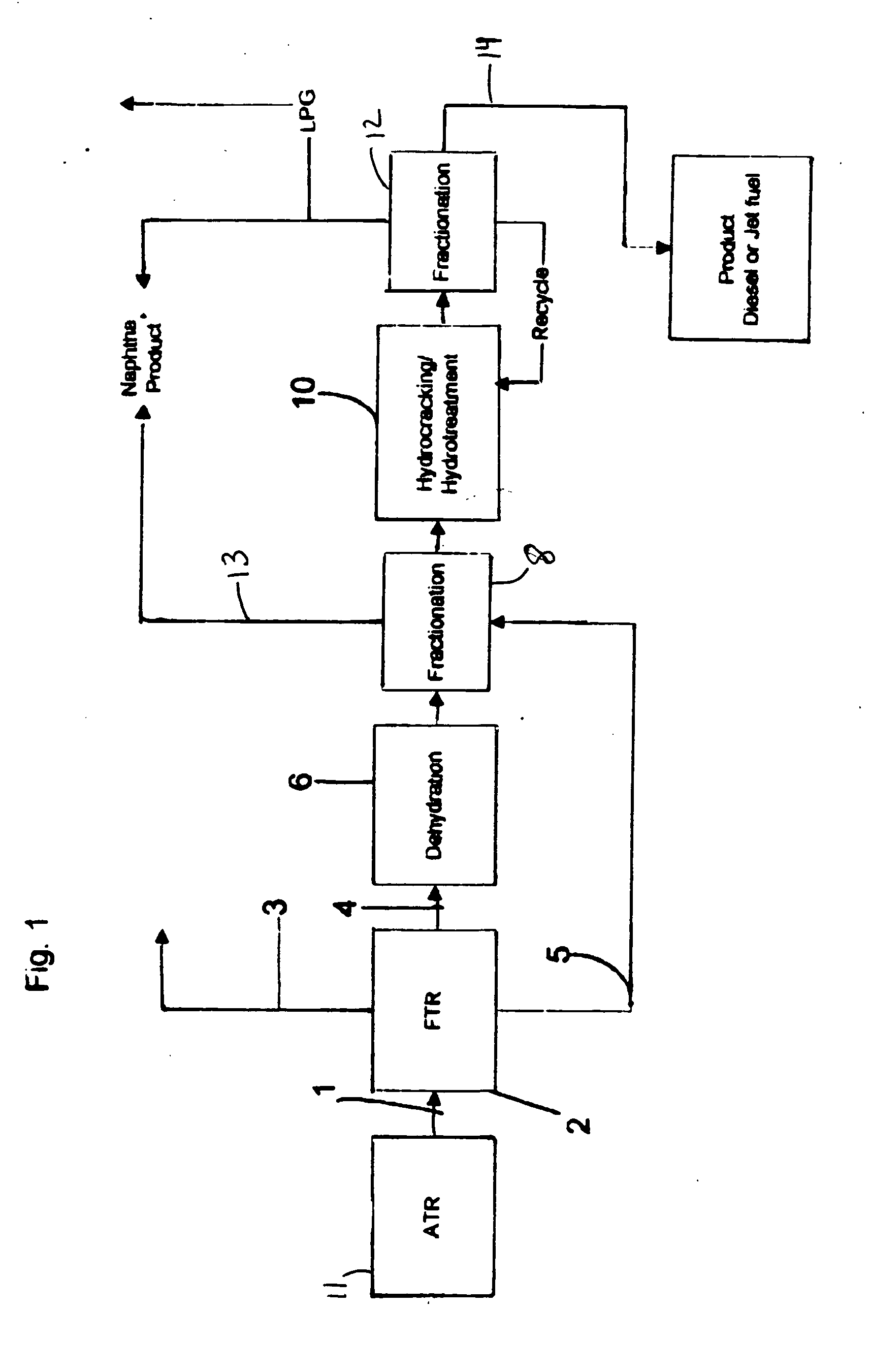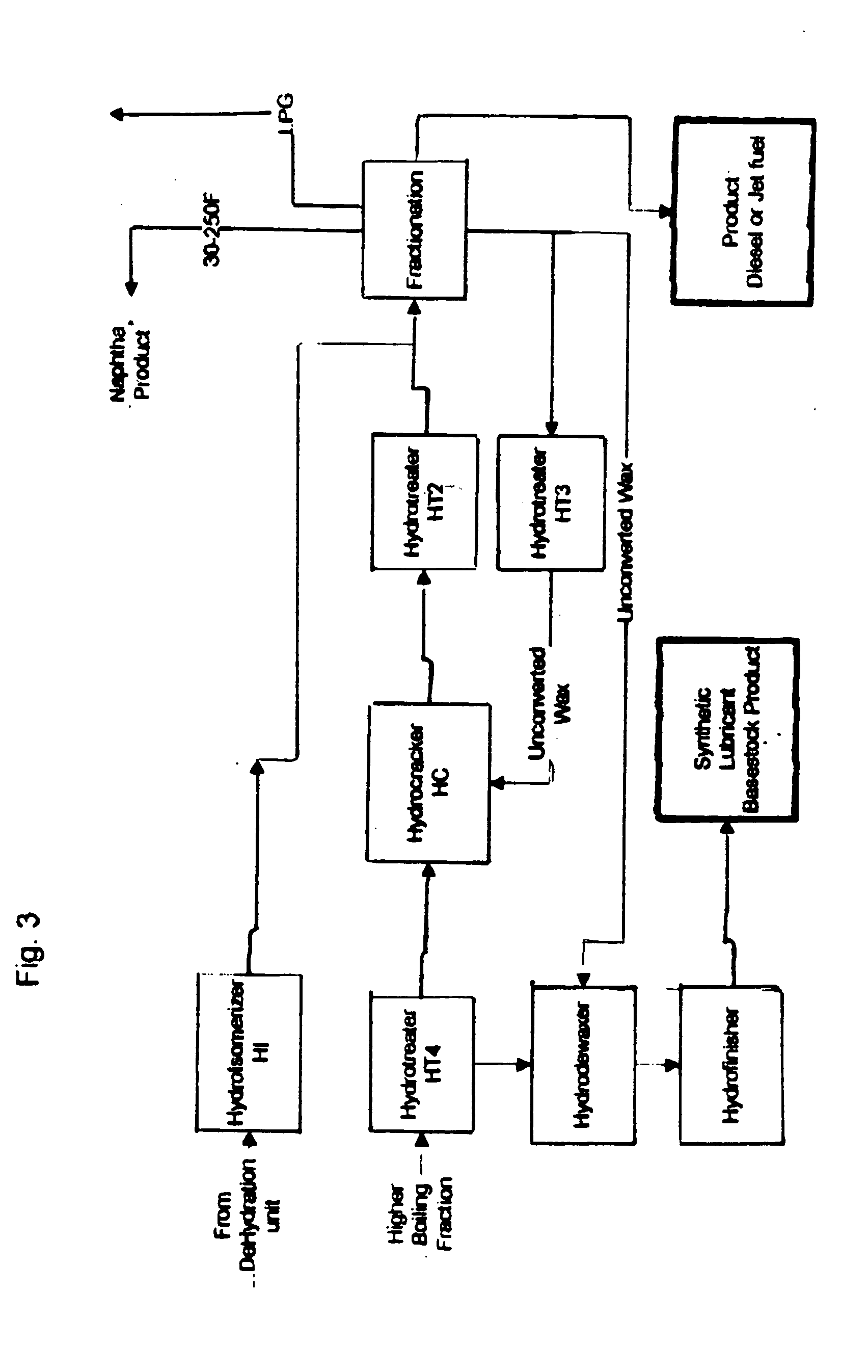Synthetic transportation fuel and method for its production
a technology of synthetic transportation and fuel, which is applied in the direction of fuels, thickeners, organic chemistry, etc., can solve the problems of increasing yield loss, affecting the quality of hydroprocessing catalysts, and necessitating a severity increase in hydroprocessing conditions, so as to improve lubricity and yield loss, the effect of reducing the temperatur
- Summary
- Abstract
- Description
- Claims
- Application Information
AI Technical Summary
Benefits of technology
Problems solved by technology
Method used
Image
Examples
example 1
[0047] A pilot installation consisting of two distillation columns was used to produce C10-13 light kerosene and C13-20+ drilling fluid feedstock streams. The columns were fed approximately 3400 g / hr of liquid Fischer-Tropsch oil. The Fischer-Tropsch oil had approximately the following composition:
Carbon #% by wt.450.0160.371.082.995.9108.1119.2129.5139.2148.4157.9167.1176.2185.4194.6203.7213.0222.3231.7241.225+2.6Total100.00
[0048] The Fischer-Tropsch oil was fed into the first column and C13 and lighter materials were distilled overhead. The column conditions were: 10 psig pressure, 480° F. feed preheat temperature, 407° F., overhead temperature, 582° F. bottoms temperature. The first column had approximately 98 inches of Sulzer Mellapack 750Y packing. The overheads of the first column was fed into the second column operating at 12 psig pressure, 370° F. overhead temperature and 437° F. bottoms temperature. The second column was packed with 28 inches of Sulzer EX packing. The bot...
example 2
[0050] 30 cc / hr of a Feed A from Example 1 was fed via a syringe pump and mixed with 20 cc / min of nitrogen. The gas / liquid mixture was introduced upflow into a vessel packed with stainless steel mesh saddles, where the liquid was vaporized and superheated to reaction temperature of 560° F. The vaporized feed was fed upflow into a reactor packed with ⅛ Alcoa S-400 alumina catalyst and suspended in a heated sandbath. The sandbath was maintained at the reaction temperature and ebulated by air. Reactor LHSV was maintained at about 0.26 hr−1. The reactor outlet was condensed and Product A and water by-product was collected in a product accumulator. System pressure was maintained by controlling the product accumulator overhead pressure at 50 psig. A water layer was drained and the organic layer product analyzed in a HP 5890 Series II GC with a 60 m RTXI capillary column with a 0.32 mm bore and 3-micron film thickness. The compositions of Feed A and Product A are reported in Table 3. The p...
example 3
[0051] 15 cc / hr of Feed A from Example 1 was processed in a benchscale process described in Example 2. The feed was vaporized and superheated to 650° F. Reactor LHSV was approximately 0.26 hr−1 to make Product A and, 0.13 hr−1 to make Product B. Composition of Product B from this example is reported in Table 3. 1H NMR analysis confirmed absence of alcohols in the product.
TABLE 3Sample Reference NumberFeed AProduct AProduct BMass %Mass %Mass %N-PARAFFIN80.6480.2379.90ALPHA OLEFIN4.438.207.96INTERNAL OLEFIN3.043.373.91BRANCHED PARAFFIN8.218.198.22ALCOHOL3.680.000.00100.00100.00100.00
PUM
| Property | Measurement | Unit |
|---|---|---|
| wt % | aaaaa | aaaaa |
| wt % | aaaaa | aaaaa |
| cloud point | aaaaa | aaaaa |
Abstract
Description
Claims
Application Information
 Login to View More
Login to View More - R&D
- Intellectual Property
- Life Sciences
- Materials
- Tech Scout
- Unparalleled Data Quality
- Higher Quality Content
- 60% Fewer Hallucinations
Browse by: Latest US Patents, China's latest patents, Technical Efficacy Thesaurus, Application Domain, Technology Topic, Popular Technical Reports.
© 2025 PatSnap. All rights reserved.Legal|Privacy policy|Modern Slavery Act Transparency Statement|Sitemap|About US| Contact US: help@patsnap.com



